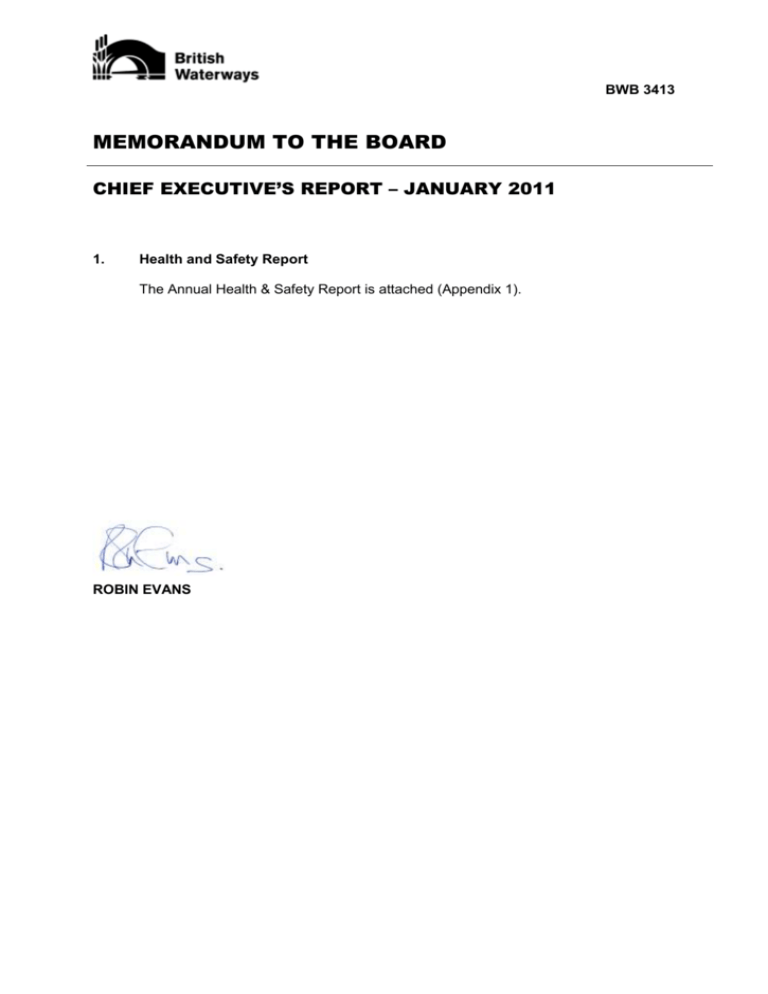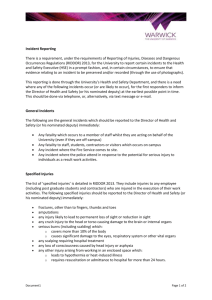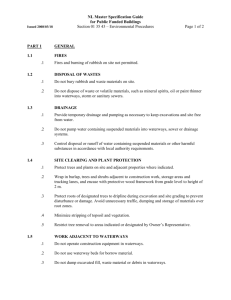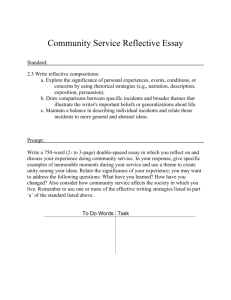CEO-Report-27-1-11-for-publication
advertisement

BWB 3413 MEMORANDUM TO THE BOARD CHIEF EXECUTIVE’S REPORT – JANUARY 2011 1. Health and Safety Report The Annual Health & Safety Report is attached (Appendix 1). ROBIN EVANS BWB 3413 APPENDIX 1 H E AL TH & S AF E T Y M AN A G E M E N T – AN N U AL R E P O R T 1.0 INTRODUCTION 1.1 This Annual Report covers the calendar year 2010. The format of the report is in line with the format of reports presented at each Board meeting during the year and covers the 4 areas of risk – Assets, Visitors, Contractors/Volunteers and our Employees. 1.2 There are items for the Board to note in this report, in particular: 1.2.1 Asset Management - Development of our risk based approach, uprating of Asset Inspection Process (AIP) and achievement of Principal Asset holding state levels (Item 3.1). 1.2.2 Visitors – Achievement of targeted reduction in infrastructure related incidents as result of Minimum Safety Standard implementation (Item 4.3). 1.2.3 Contractor/Volunteer Safety – There was one reportable incident during the period involving a contractor and one involving a volunteer (Item 5.0). 1.2.4 Employees – Negative performance against targets for reducing Lost Time Injuries (LTI), Manual Handling Injuries, and Slips, Trips and Falls, but positive improvement in the worrying trend in major injuries which occurred in 2009. A comprehensive range of actions are in place to improve management, supervisory and workforce performance in risk management and safe behaviour (Item 7.0). 2.0 OVERVIEW 2.1 General 2.1.1 The principal focus in 2010 was in the areas of compliance and safe behaviour. 2.2 Compliance 2.2.1 During 2010, the vast majority of managers within British Waterways have undertaken a compliance self-audit using the BWISE computerised software system. This is the first time this system has been used by managers in this way. Analysis of the results will take place in the first quarter of 2011 and we anticipate high levels of compliance based on the actions completed by managers throughout the period of the self audit. 2.3 Minimum Safety Standards 2.3.1 The introduction of Minimum Safety Standards as a subset of our Customer Service Standards (CSS) has had a significant positive impact on customer safety. Focus in 2010 has been to maintain the improvement with specific focus on lock gate fendering to reduce risks of boat hang ups and sinkings. 2.4 Employee Health and Safety 2.4.1 The improvement in employee incident trends has stalled, with an increase of 10% in the Lost Time Injury metric compared with the start of the year. We are focusing on safe behaviour as a primary means of improving safety performance through the roll out of safety training based on the DVD shown to the Board at the last meeting and a comprehensive range of associated actions. The vast majority of incidents in 2010 were at the upper limit of consequence in that the injuries sustained by employees were unlikely to be more severe than those actually suffered. Whilst the number of these “minor” injuries is of concern, it is pleasing that high consequence injuries have been avoided during the year. We believe this is a direct result of actions taken to raise awareness, emphasise the importance of safe behaviour and improved management risk assessment. 2.4.2 The benchmark for comparing our safety performance with the construction industry saw us drop back outside the upper quartile during the year. The benchmark is based on RIDDOR (over 3-day absence) reportable incidents only (See Para. 6.5). Identifying benchmarks that cover the full range of our activities is not straightforward and, therefore, comparing across a number of benchmarks is necessary. An example of an additional benchmark is given at Para. 6.6 showing our Lost Time Injury performance under the “Safety, Health and Environment Intra Industry Benchmarking Association”. Under this comparison, our safety performance is comparable with a grouping of companies that includes British Gas, Pepsico and Laing O’Rourke where Lost Time Injuries are in the range 0.5 to 1 per 100,000 hours worked. Put another way, a worker at British Waterways would, on average, suffer a Lost Time incident once in their working lifetime. Better performing organisations have incident frequency rates of 0 to 0.5 and the poorer performing organisations such as Environment Agency and Royal Mail are in the range 1 to 2.5 incidents per 100,000 hours worked. 2.4.3 The external verification of our health and safety arrangements was undertaken by RoSPA in March/April 2010. The RoSPA audit recognised good standards, procedures and implementation, but recommended improving the written management system to link the elements together. This improvement work has been done, which means as we move towards the NWC we have a robust documented system which sets out clearly how safety is managed. 3.0 ASSETS 3.1 Asset Management 3.1.1 The mapping and gap analysis to benchmark our asset management systems against the Publicly Available Specification for asset management (PAS-55) led to the development of a project plan for our Asset Management Plan (AMP12). This is designed to take account of reduced Government funding levels, our move to the Third Sector, changed responsibility for assets in Scotland and potentially the vesting of some EA navigational assets in the NWC. AMP12 will ensure that the NWC can meet the standards and obligations placed on British Waterways by Government to operate a risk based approach to asset management comparable to PAS 55. 3.1.2 Our Asset Inspection Procedure (AIP2008) underwent an annual review. Minor amendments are planned with respect to inspections of buildings and waste tips. The Length Inspection handbook was revised to take account of Minimum Safety Standards and the use of mobile technology to capture data. Further revision is required in 2011 pending decisions on the use of ZQ and Z4 notifications. 3.1.3 Monitoring of the effectiveness of our inspection programme continues by means of quarterly traffic light reports. This allows continuous audit and implementation of any corrective actions required. 3.1.4 Network Stewardship Score was externally reviewed and validated by Deloitte. NSS for 2008/09 (Score 100) and 2009/10 (Score 107) were calculated. The Waterway Condition Index facet of NSS includes measures of network condition, serviceability, compliance and safety related incidents. 3.1.5 The November 2009 restructure brought 3 building surveyors responsible for all operational buildings in England and Wales under the wing of asset management. Scotland has also been supported to bring its building procedures up to date. Much of the year was spent inspecting, validating and correcting data held on our 1,200 operational buildings to ensure we have good asset knowledge and a consistent approach. We identified a number of corrective actions to ensure we fully meet our statutory obligations regarding asbestos, legionella, gas safety, fire risk assessments, water and drainage. These actions are now in place and on regularised cycles within Waterway Unit Business Plans and in the Steady State model. Building on this work in 2011 will ensure that non-compliance with statutory obligations is eradicated. 3.2 Asset Condition 3.2.1 Our objective of holding the proportion of D and E principal assets at no more than 22% was achieved, with 17.8% at this level at the end of 2010. 3.2.2 Asset Management undertook a number of asset audits across British Waterways to ensure the consistency of our underlying asset data on which we base many of our management decisions, and on which our risk strategy is based. This work will continue. 3.2.3 Further work has been done on the identification of higher risk embankments, and plans are in place to load additional asset data into SAP in 2011. This work feeds directly into the Breach Risk modelling being managed by the Water Management team and supported by asset management resources. The outputs will provide British Waterways with a much more informed picture of the location and scale of high risk infrastructure assets and will allow better optimisation of expenditure of maintenance and repair work. 3.3 Property 3.3.1 Over the past year, there has been a significant effort to achieve compliance with both statutory and British Waterways Standards. One area that was previously identified as being non-compliant was the provision of landlord’s safety certificates for services within residential properties. Due to a concerted effort, testing has been completed across the majority of the estate. 3.3.2 In order to comply with the Control of Asbestos regulations and improve our general management of this extremely hazardous material, a new Asbestos Management Plan has been prepared for Property. This will aid, with the management of asbestos containing materials, the planning of works and it will provide an improved means for demonstrating that British Waterways are dealing with asbestos responsibly. 3.3.3 The management of the vacant property that British Waterways holds remains one of the most significant health and safety risks. Each vacant property has a safety risk assessment in accordance with the British Waterways Standards. Control measures are implemented and the residual hazards identified are communicated to visitors and managing agents. Where standards and regulations change, this needs to be communicated to staff, and in response to this personnel, those with greater experience and specific knowledge or expertise are encouraged to share this with colleagues. 3.3.4 The new Gateway site has offered an opportunity to review all standards before they are placed on the site and it will be necessary to periodically review these standards to ensure that they remain current as well as to remind staff of the necessity for compliance. 3.4 Port Management 3.4.1 The Port Marine Safety Code (PMSC) is a non-statutory Standard produced by the Department for Transport (DfT), compliance with which enables harbour authorities to demonstrate that their statutory duties for marine operations have been discharged by using the powers available to them. The code was re-launched in October 2009. The PMSC requires the identification of three specific posts; the Duty Holder, discharged in British Waterways by the Board, the Designated Person which is fulfilled by the Operations Director and Harbour Master fulfilled by competent local people. British Waterways’ designated ports are: London Docklands Sharpness Docks River Ouse Caledonian Canal Crinan Canal 3.4.2 During 2010, we commissioned an independent external audit of our approach to PMSC to verify that our arrangements are appropriate. The audit substantially validated our approach. The Management of the ports was identified as being good and the only improvement recommendations related to the written management systems which have been implemented. 4.0 VISITOR SAFETY 4.1 General 4.1.1 The focus on Minimum Safety Standards continues to have a major impact on public and customer safety and we are confident that the programme has had a notable effect on reducing the number of visitor incidents involving our assets. A particular focus in 2010 has been on lock gate fendering, with revised guidance and a programme of inspection and remedial action on-going. 4.1.2 The programme of raising awareness of lock cill hazards continues to be a success, with a continued noticeable reduction in cill related sinkings down from a peak of 18 incidents with 12 boats sunk or seriously flooded in 2007 to 9 incidents with no cill related sinkings in 2010. 4.1.3 There was 1 HSE reportable customer injury in 2010. A customer was injured when a coping stone gave way as they were disembarking a boat at a water point. 4.2 Boating Incidents 4.2.1 The most significant incident in 2010, was the death of a female boater who was killed when a tree fell onto the boat she was steering on the Grand Union Canal during a summer storm. The tree situated on the offside, was not on property owned by British Waterways. British Waterways conducted an investigation and found that appropriate arrangements were in place to manage the risks from trees. MAIB/HSE conducted an investigation and, although not formally closed out, no remedial action for British Waterways has been identified by HSE. The learning points identified so far have been incorporated into the tree inspection and management processes, particularly the contract with Fountains. 4.3 All Incidents 4.3.1 The trend in incidents established up to 2007 indicated that 15% of incidents reported by visitors were infrastructure related insofar as there was a defect that would warrant repair. A medium term goal of reducing this to 10% was set at the beginning of 2007. The Minimum Safety Standards take into account what was learnt from analysis of causes and that focus is having an impact. The charts below indicate a reduction of infrastructure related visitor incidents has been maintained in the target area in 2010 at 10.7% of incidents reported by Customers. 4.3.2 These are broken down as shown in the following pie charts. The following charts show the outcome of the quarterly analysis of the visitor incidents reporting to British Waterways in the first 9 months of 2010. 4.4 Water related Fatalities 4.4.1 The following chart shows the trend of water related fatalities. They cover all incidents of which British Waterways are aware where the deceased was recovered from the water. British Waterways conducts an initial investigation to identify whether there are contributory factors within the control of British Waterways and, for appropriate incidents, we advise the Coroner’s court of our interest in the events. 4.4.2 56 deaths were reported in 2010 40 Accidental 8 Intentional (includes suicides, crime and natural causes) 8 Unknown BWML Central Shires East Midlands Kennet & Avon London Manchester & Pennine North East North Wales & Borders North West Scotland South East South Wales & Severn West Midlands 1 1 4 2 2 6 5 3 11 7 7 5 2 4.4.3 The North West of England remains a challenging area, with Manchester City Centre a particular problem. We are working closely with Manchester City Council and the Greater Manchester Police to address the issues which commonly involve antisocial behaviour and alcohol related incidents. 5.0 CONTRACTORS AND VOLUNTEERS 5.1 Contractors 5.1.1 There was 1 Riddor reportable contractor injury in 2010. A plant operator employed by a subcontractor at Redbrook reservoir alighted from excavator cab to take a break. He stepped over the machine blade and tripped over the stone rubble he had been clearing. First aid was rendered on site and he was taken to hospital where he received 12 stitches to a head injury. 5.2 Volunteers 5.2.1 28 Volunteer organisations have been assessed as competent to undertake the day to day supervision of their own activities for specified low risk tasks. Other volunteer activities are directly supervised by British Waterways. There has been 1 significant injury reported to a volunteer. 5.2.2 A volunteer working in the South Wales & Severn Waterway on the Monmouthshire & Brecon Canal suffered broken bones in his hand when another volunteer closed a minibus side door on his hand as he returned to the crew bus – the volunteer was back working after 1 day off. 6.0 EMPLOYEE OCCUPATIONAL HEALTH AND SAFETY 6.1 Lost Time Incidents 6.1.1 Our headline measure is ‘Lost Time’ incidents rather than RIDDOR reportables. There has been deterioration in the overall Lost Time Injuries during 2010 (Chart 6.2 below). The worrying feature of 2009 was the increase of major injuries, this trend was reversed in 2010 with a reduction to 1 major injury resulting from an employee jumping off a boat and breaking his leg. There has been a modest increase in overall Lost Time Injuries in 2010. Our focus on safe behaviour in the last quarter of 2010 and into 2011 is designed to address this deterioration by focussing on the behaviour and “just get on with it” attitude of many of our frontline employees. Although the number of reportable incidents has increased the severity of injuries is predominantly at the limit of consequence and unlikely that higher consequences injuries could have occurred. The 22 reportable incidents where employees took more than 3 days time off work broadly fell into the following categories. 6.1.2 All front line operational managers and supervisors were gathered together during January 2010 where major injuries were focussed on together with messages about the importance of planning and safety leadership were emphasised. We have started to re-invigorate the workplace safe behaviour activities in British Waterways and all operational teams now have a team leader trained (or in the process of training) in behavioural safety improvement techniques, supported by safety representatives to focus on improving safety behaviour of frontline employees. In addition, all Supervisors will have achieved NEBOSH or NVQ safety qualification by mid 2011 and all operational managers will have been trained in improved Risk Management Assessment. 6.1.3 By the end of 2011, all new employees and British Waterways’ volunteers will have completed the Safety Induction course which introduces them to the safe behaviour approach. 6.1.4 The overall trend in all types of injuries continues to be downwards when first aid cases and minor injuries are included (see charts in 6.3 below) and this indicates that our overall approach to safety improvement has had a positive effect over time. However, the really frustrating area is the stalled nature of Lost Time Injuries (Chart 6.2) and particularly the increasing amount of RIDDOR reportable incidents where employees have taken more than 3 days time off work. It is possible that the levels of uncertainty and change in the business may promote an attitude in some people that taking more time off than is really necessary is acceptable, but we do not have any hard evidence to support such a view. 6.1.5 There have been 2 reported cases of occupational ill health. 2 employees in South East business unit have been diagnosed with early symptoms of HAVS and are subjected to restricted exposure to vibration. Both employees have over 30 years’ service with British Waterways and have undertaken piling and agricultural work in the past. HSE inspectors reviewed the cases and expressed some concerns about a delay in diagnosis by our occupational health provider. The experience from this case has been incorporated into revised arrangements for the new Occupational Health Contract which was in place for 2011. 6.1.6 Progress against Targets 2010/11 6.2 - 20% reduction in Lost Time injuries to British Waterways’ employees (start point 28, March 2010) – outcome 31 for 12 months to December 2010 -10% Increase - 10% reduction in Manual Handling injuries (start point 16, March 2010) outcome 25 for 12 months to December 2010 - 36% Increase - 10% reduction in Slip/Trip/Fall injuries (start point 32, March 2010) - outcome 33 for 12 months to December 2010 – 3% Increase - 300 worksite safety audits by management team members - progress to the end of December 2010 – 314 site audits, 358 safe behaviour discussions - Achieve 100% of visitor risk assessment plan – 90% reported complete Performance Statistics – The following table illustrates that we continue to have a plateau in our safety performance relating to the more serious injuries. Our safety training focus is aimed at addressing this as we firmly believe that improving personal safety behaviour is key. The overall recorded injuries continue to decline, but the rate of improvement has slowed (see para. 6.3). 6.2 Total Incident Trend – The following table illustrates that the overall injury trend has stalled at around 100 recorded injuries per annum - down from over 200 4 years ago, and around 300 in earlier years when all types of injury were included. 6.4 LTI Causes – In line with previous years and most industries, the following table illustrates that Manual Handling and Slips, Trips and Falls related injuries continue to be the most common. Improving personal safety behaviour is the only way to significantly improve performance in these areas as it is impractical to have closer supervision given the resources we have available. 6.5 Construction industry Safety Benchmark - This table illustrates British Waterways’ position against the Construction Industry. Our Framework Contractor, May Gurney, do not subscribe to this benchmarking service and we monitor their safety performance under the contract terms. All indications so far suggest that their safety management systems would place their safety performance at the upper quartile on this benchmark. 6.6 Safety, Health and Environment Intra Industry Benchmarking Association – This benchmark service includes a wide range of industry representatives covering construction, facilities management, power, water, rail and service industries. We have plotted the British Waterways’ position for incident rates per 100,000 hours worked for 2009/10 (This is the typical number of lifetime hours worked by an individual – frequency of 1 indicates that on average every worker in the organisation would suffer 1 Lost Time Injury during their working life). 7.0 CONCLUSION 7.1 From the four key corporate safety risk areas, our greatest concern relates to Employee safety. 7.2 A wide ranging Safety Improvement Programme is in place which is a significant investment mainly of employee time. Although we are in a period of severe financial challenge, we are determined to improve our safety performance for the benefit of our employees and also for our corporate reputation. In the period of intense change within the business, we believe passionately that safety must remain our number one priority with improved safe behaviour the key target area. 7.3 The summary of the main safety improvement actions that are in the process of delivery during 2011 building on work done in 2010 are: Safety Improvement Action Target DVD based Behavioural Safety Training programme DVD based Improving Risk Management assessment Supervisors safety accredited through NEBOSH or NVQ Work team member behavioural safety coach trained Improved safety induction process for all new starters and volunteers Improved Near Miss reporting rewards Site safety audit process with regular analysis and communication of trends Regular Tool Box talks (short on site safety discussions) on key risks – with Slips/Trips/Falls and Manual Handling predominating All operatives covered by March 2011 All operational line managers covered by June 2011 All completed or close to completion by June 2011 At least one in place in each work team now In place In place In place Programmed through year Regular safety messages communicated through short employee involved in-house produced DVDs Union Safety Representatives fully engaged with Safety Improvement Programme Safety related disciplinary code approved by Joint Management/Union National Safety Committee Safety improvement target in all operational managers Personal Performance targets Programme under development On going In place Implemented in 2010 for assessment April 2011 7.4 We have critically assessed the improvement programme that is in place and benchmarked our approach with other organisations and we are confident that we have a comprehensive programme in place. Our safety systems have been approved by RoSPA, we have improvement actions aimed at every operational safety aspect (equipment, training, audit) and we know that the most significant area for improvement is the “just get on with it” approach of many of our frontline employees. In a time of change, our challenge is to convince our largely closely unsupervised workforce that stopping and thinking before acting is not only good for their safety, but the most efficient way of working. 7.5 The comprehensive Safety Improvement Programme that has been designed and rolled out this year will be critically assessed during the year and fully reviewed at the end of 2011.





